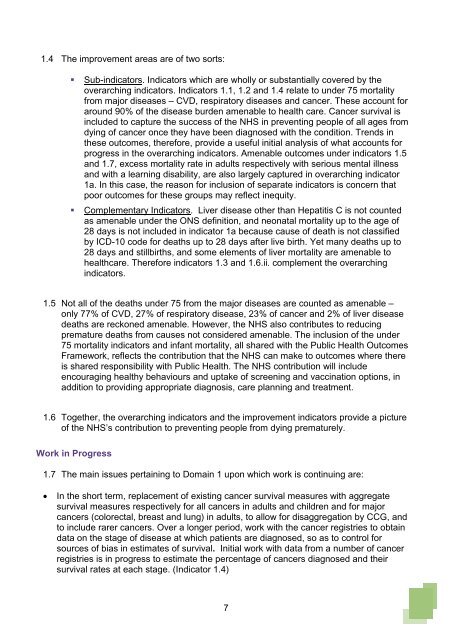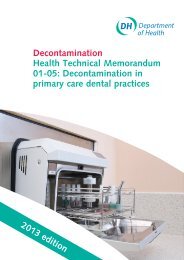The NHS Outcomes Framework 2013/14 Technical Appendix - Gov.uk
The NHS Outcomes Framework 2013/14 Technical Appendix - Gov.uk
The NHS Outcomes Framework 2013/14 Technical Appendix - Gov.uk
Create successful ePaper yourself
Turn your PDF publications into a flip-book with our unique Google optimized e-Paper software.
1.4 <strong>The</strong> improvement areas are of two sorts:• Sub-indicators. Indicators which are wholly or substantially covered by theoverarching indicators. Indicators 1.1, 1.2 and 1.4 relate to under 75 mortalityfrom major diseases – CVD, respiratory diseases and cancer. <strong>The</strong>se account foraround 90% of the disease burden amenable to health care. Cancer survival isincluded to capture the success of the <strong>NHS</strong> in preventing people of all ages fromdying of cancer once they have been diagnosed with the condition. Trends inthese outcomes, therefore, provide a useful initial analysis of what accounts forprogress in the overarching indicators. Amenable outcomes under indicators 1.5and 1.7, excess mortality rate in adults respectively with serious mental illnessand with a learning disability, are also largely captured in overarching indicator1a. In this case, the reason for inclusion of separate indicators is concern thatpoor outcomes for these groups may reflect inequity.• Complementary Indicators. Liver disease other than Hepatitis C is not countedas amenable under the ONS definition, and neonatal mortality up to the age of28 days is not included in indicator 1a because cause of death is not classifiedby ICD-10 code for deaths up to 28 days after live birth. Yet many deaths up to28 days and stillbirths, and some elements of liver mortality are amenable tohealthcare. <strong>The</strong>refore indicators 1.3 and 1.6.ii. complement the overarchingindicators.1.5 Not all of the deaths under 75 from the major diseases are counted as amenable –only 77% of CVD, 27% of respiratory disease, 23% of cancer and 2% of liver diseasedeaths are reckoned amenable. However, the <strong>NHS</strong> also contributes to reducingpremature deaths from causes not considered amenable. <strong>The</strong> inclusion of the under75 mortality indicators and infant mortality, all shared with the Public Health <strong>Outcomes</strong><strong>Framework</strong>, reflects the contribution that the <strong>NHS</strong> can make to outcomes where thereis shared responsibility with Public Health. <strong>The</strong> <strong>NHS</strong> contribution will includeencouraging healthy behaviours and uptake of screening and vaccination options, inaddition to providing appropriate diagnosis, care planning and treatment.1.6 Together, the overarching indicators and the improvement indicators provide a pictureof the <strong>NHS</strong>’s contribution to preventing people from dying prematurely.Work in Progress1.7 <strong>The</strong> main issues pertaining to Domain 1 upon which work is continuing are:• In the short term, replacement of existing cancer survival measures with aggregatesurvival measures respectively for all cancers in adults and children and for majorcancers (colorectal, breast and lung) in adults, to allow for disaggregation by CCG, andto include rarer cancers. Over a longer period, work with the cancer registries to obtaindata on the stage of disease at which patients are diagnosed, so as to control forsources of bias in estimates of survival. Initial work with data from a number of cancerregistries is in progress to estimate the percentage of cancers diagnosed and theirsurvival rates at each stage. (Indicator 1.4)7
















